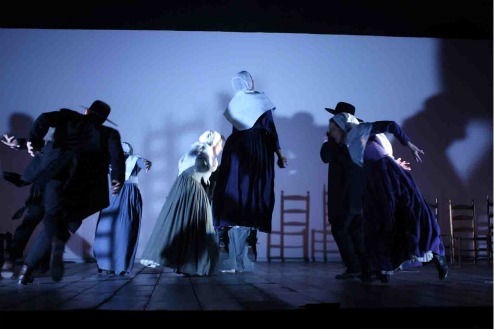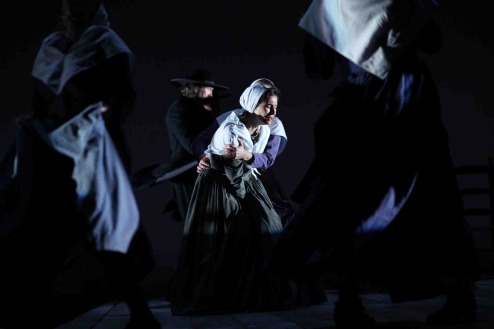Angel Reapers, by Martha Clarke and Alfred Uhry / Joyce Theater, NYC / November 29 – December 11, 2011
The oddest thing about Martha Clarke and Alfred Uhry’s Angel Reapers is that it has no plot. This despite the fact that Uhry is a widely respected American playwright, as his Pulitzer, Oscar, and Tony awards attest. Clarke herself, a founding member of the tremendously popular Pilobolus, is widely known for haunting dance-theater pieces, in which her vivid imagination and penchant for the perverse reveal the world’s underside. A MacArthur Fellowship (the “genius grant”) tops her long list of awards. How could she not have noticed that the 75-minute work she and Uhry had concocted about that unique American religious sect, the Shakers, desperately needed the architecture and propulsion of a story? As matters stand, Angel Reapers plays like a documentary, though it’s not at all clear how much of its content is fact and how much fiction. What’s worse, it doesn’t seem to have any point.

The Dark Is Light Enough: A scene from Martha Clarke and Alfred Uhry’s Angel Reapers
Photo: Rob Strong
Two things commonly known about the Shakers: One: They were committed to the rule of celibacy. Two: Along with spoken testimony to their rigorous principles (at its most ecstatic, speaking in tongues) and confession of their infringements, their rites included movement: stepping, stomping, and shaking that mounted in intensity in order to exorcise their sins. The violence of this “dancing” was like that of spiritual possession, its climax occasionally ending in a faint. (A third fact generally known about the Shakers is that they constructed home furnishings breathtaking in their purity of form, but let that pass, since Clarke and Uhry didn’t find it pertinent.)
Here’s what the creators of Angel Reapers did give us. A cast of six women and five men who can, to varying degrees, dance, sing, and move eloquently. The movement element is well covered by having the best dancers doing the challenging parts such as falling heavily to the floor and writhing vigorously in the throes of religious, or plain human, passion. The a cappella singing of authentic Shaker work songs and hymns sounds quite natural and blessedly avoids theatricality. It goes without saying that “Tis a Gift to Be Simple” is represented; Aaron Copland eked out a whole ballet for Martha Graham–Appalachian Spring–from it. The spoken word doesn’t fare so well; the performers with insufficient training in diction and projection are not convincing. Strangely enough, none of the people on stage seems fully “real”– either as a character identified in the program (Sister Susannah Farrington, an abused wife; Brother Moses, a runaway slave) or as a fully confident performing artist, so it’s hard to empathize with them. We’re not drawn into their world; we just watch them from afar.

Angel Unaware? Asli Bulbul in Angel Reapers
Photo: Rob Strong
We first see the full cast at its communal worship, making clear what dictates they’ve vowed to obey. Gradually we learn how each member became part of the community. (This material has more than a hint of AA meetings behind it.) Eventually we come to various members’ breaking the sect’s stringent rules, for the most part the one about chastity. The issue is, of course, the tension between the Shakers’ will–which could prevail only in a community giving itself over to group hysteria–and human reality. Inevitably a man and a woman touch–merely touch–and the whole house of cards collapses. Intercourse has its day, heterosexual first, then, Clarke being an equal-opportunity artist, same-sex (a gorgeous duet, featuring lifts that are also embraces, represents a pair of men coupling). Last, a radiantly pregnant woman and her partner leave the fold. Mother Ann Lee, historically the woman who brought the sect to America, gets worried. Very worried. And, ambivalent. An uncompromising leader, she only wanted to teach her chosen people how to live in order to be sure of Heaven when they died. Now she’s beginning to feel some very human sympathy for the transgressors.
The end of the piece remains an enigma to me. Left alone, the despairing Mother Ann has a flesh-and-bone vision of four men who are buck naked, though never in full-frontal view of the audience. (Granted, this modesty may have something to do with local laws.) One member of the quartet, William, who is Ann’s brother, points out, “My soul is an angel. My body is a man. They are at war–man and angel. The angel is pure. The man is strong. I fight him. I never win. Why is it so hard?” When he leaves, Ann is alone again, sitting in one of the sect’s unforgiving straight-backed chairs. We see her in profile, as if in effigy, and hear her singing, faintly but clearly, as if to sustain her own faith, while the light fades to dark.
Go to see this venture if you like, but keep in mind the fact that Doris Humphrey, a key choreographer of mid-20th-century modern dance, did the subject shorter and better. The Dance Division of the New York Public Library for the Performing Arts, at Lincoln Center, will show you The Shakers, made by Humphrey in 1931, on film–for free.
The performers in Angel Reapers are Sophie Bortolussi, Asli Bulbul, Patrick Corbin, Lindsey Dietz Marchant, Birgit Huppuch, Gabrielle Malone, Peter Musante, Luke Murphy, Andrew Robinson, Whitney V. Hunter, and Isadora Wolfe.
© 2011 Tobi Tobias




As one who has never found Martha Clarke’s work “haunting,” I didn’t see this work. But I would point out that to say that “Aaron Copland eked out a whole ballet for Martha Graham–‘Appalachian Spring’–from it,” the hymn ‘Simple Gifts’ is simply not correct. He does indeed use it to wonderful effect in “Appalachian Spring” but only in the context of an entire score of which this hymn becomes a most effective part, not the basis for the entire work. To suggest that it’s a series of variations on this one tune is to undervalue the originality of this seminal score. Just give the entire work a listen, not the more familiar suite, and you’ll surely see what I mean.
I wonder about your review, as it seems haunted by Humphrey’s work. Clarke’s previous work, on Brueghal, was workshopped and premiered in New Jersey, and I was a humanities commentator for it. I found Clarke’s “field-oriented” aesthetic refreshing. Now, the Breughel painting WAS a field, literally and figuratively, so that was an aesthetically intrinsic choice on her part, I suspect. But Shakers seemed to trying to step out of the (Western) world and its narrativizing tendencies (“I am a character, in a plot, with tension”). Couldn’t there be a choreographic match with their interest in stepping outside that narrative discourse? Perhaps the tension between your instinct for story and the non-narrativized choreography could be a aesthetic avatar for the Shaker’s own conflict?
What you said about “point,” “structure… architecture” assured me that the dance world has not quite gone mad. Keep the wonderful writing going.
I am very happy to receive your writing in all its forms!
I think it would be best for a critic not to use the “we” in relation to personal opinions and views.
In relation to “Angel Rapers” my feelings are so different from yours. True, it did not have a narrative structure, but it had so much else that was so satisfying to watch and experience.
I found several segments of the work deeply moving, including the nudity at the end. In a way the nudity section was a cathartic outcome to the sexual tension prevalent throughout the work. This element was missing from Humphrey’s work, as structurally perfect as it was.
The edges of the movement in Humphrey’s “The Shakers” are so stiff and in Martha Clark’s they are allowed to bend and give in to the vulnerability and the sense of feeling lost in the private and collective experiences I witnessed and which I so appreciated.
..reads like a “not nitpicking review” on an overworked subject, that suffers from a multitude of “critic diseases” 1. seeing the original 2. with great stars 3. attending 65 versions in 40 yrs 4. visiting shakertowns in august 5. hearing appalachian spring every week on wqxr since 1963. etc. etc.
sounds like an hour was just perfect.